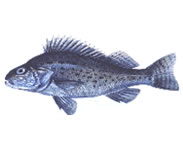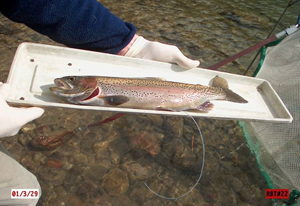- Home
- About S&T
- Taxa/Organisms
- Ecosystems
- Issues
- Methods & Tools
- Reports & Publications
- Location
- Search
Publisher: USGS | Science Center: Florida Integrated Science Center (FISC, Gainesville) | Format: URL
fl.biology.usgs.gov — The red shiner (Cyprinella lutrensis) is a hardy, widespread minnow native to the middle and southwestern United States and Mexico. Its native range encompasses the lowland tributaries of the Mississippi River and western Gulf slope drainages to the Rio Grande River. The red shiner peripherally occurs in the southeastern United States, inhabiting More...

Publisher: USGS | Science Center: Upper Midwest Environmental Sciences Center (UMESC, LaCrosse) | Format: URL
www.umesc.usgs.gov — The Long Term Resource Monitoring Program (LTRMP) has been collecting Asian carp from the Upper Mississippi River System (UMRS) and documenting changes in abundance and size structure. This research summary shows the annual increase in number of catches since 1990 and compares habitat type and collecting gear types to the percentage of catches.

Publisher: USGS | Science Center: Upper Midwest Environmental Sciences Center (UMESC, LaCrosse) | Format: URL
www.umesc.usgs.gov — Eurasian Ruffe pose a threat to native fish because they(1) mature quickly, (2) have a high reproductive capacity, and (3) easily adapt to new environments. Ruffe were first detected in western Lake Superior in 1986. UMESC scientists are conducting research on various types of piscicides (chemicals that kill fish). They are attempting to develop More...

Publisher: USGS | Science Center: Upper Midwest Environmental Sciences Center (UMESC, LaCrosse) | Format: URL
www.umesc.usgs.gov — Zebra mussels have caused drastic declines in native clam and mussel populations in some locations. Zebra mussels compete with other invertebrates and young fish for plankton, the primary food source for these groups. UMESC scientists are investigating the effects zebra mussels are having on the riverine ecosystem. This study examines the effects More...

Publisher: USGS | Science Center: Florida Integrated Science Center (FISC, Gainesville) | Format: URL
fl.biology.usgs.gov — The African jewelfish (Hemichromis letourneuxi) has been established in canals surrounding the Miami area since the 1960s. With changes in water delivery to the park, the species has recently (2000) entered Everglades National Park and expanded its range westward through Big Cypress National Preserve. Simultaneously, African jewelfish from a More...

Publisher: USGS | Science Center: Florida Integrated Science Center (FISC, Gainesville) | Format: URL
fl.biology.usgs.gov — The Nile tilapia (Oreochromis niloticus) is commonly used in aquaculture worldwide. Feral populations exist in many regions where individuals escape culture and establish in natural habitats. In Mississippi, Nile tilapia are established in at least three distinct localities (fig. 1): the lower Pascagoula and Escatawpa river drainages, and a More...

Publisher: USGS | Science Center: Florida Integrated Science Center (FISC, Gainesville) | Format: URL
fisc.er.usgs.gov — Snakeheads (family Channidae) are airbreathing freshwater fishes containing two genera, Channa with 26 species native to Asia, Malaysia, and Indonesia; and Parachanna with 3 species native to tropical Africa. Some snakeheads are small, reaching about 17 centimeters, but most are much larger, the largest reported to be 1.8 meters in length. All are More...

Publisher: USGS | Science Center: Western Ecological Research Center (WERC, Sacramento) | Format: URL
www.werc.usgs.gov — Riparian vegetation is intimately linked to the stream and river channels along which it grows. This project addresses the status of the riparian zone along Redwood Creek north coastal California, and answers three questions: 1) How have the overstory riparian conditions changed in Redwood Creek and major tributaries since the advent of timber More...

Publisher: USGS | Science Center: Northern Rocky Mountain Science Center (NRMSC, Bozeman) | Format: URL
nrmsc.usgs.gov — This research project examines dispersal and several components of fitness between hybrids and non-hybridized fish. Further, scientists will examine the relationship between environmental factors and genetic and demographic characteristics of hybrid populations. The specific objectives are: (1) to compare the spawning dynamics and dispersal More...

Publisher: USGS | Science Center: Florida Integrated Science Center (FISC, Gainesville) | Format: URL
fl.biology.usgs.gov — This web resource is a map representation of the distribution of zebra and quagga mussels in U.S. lakes. Zebra mussels were first detected in 1988 in Lake St. Clair, located between Lake Huron and Lake Erie. Within just a few years, they spread into all five of the Great Lakes. Since then, zebra mussels have spread into many large navigable More...

Publisher: USGS | Science Center: Western Fisheries Research Center (WFRC, Seattle) | Format: URL
wfrc.usgs.gov — The general objective of this collaborative project is to investigate and improve habitat-based ecological modeling on large rivers. While many ecological aspects of large-river alteration have been investigated previously, there has been little emphasis on how alterations of physical habitat interact with life histories, biotic interactions, and More...

Publisher: USGS | Science Center: Upper Midwest Environmental Sciences Center (UMESC, LaCrosse) | Format: URL
www.umesc.usgs.gov — Gobies are capable of rapid population growth after they reach new areas. They have shown the ability to out-compete native fish for food and habitat. Another area of concern involves potential predation on the eggs and fry of lake trout. After first being discovered in 1990 along the St. Claire River (a Canadian river north of Detroit), gobies More...
